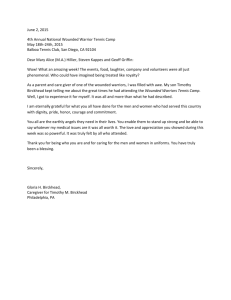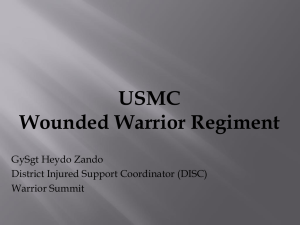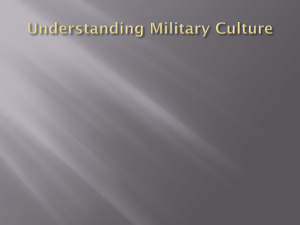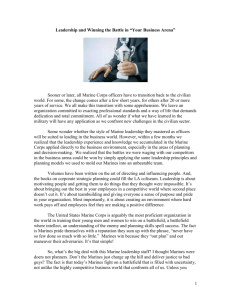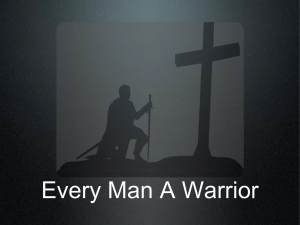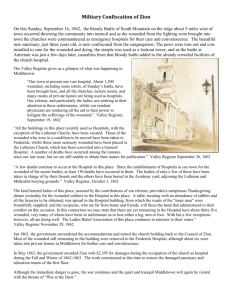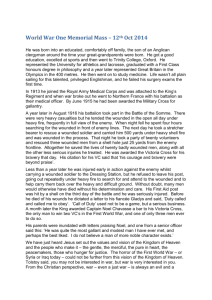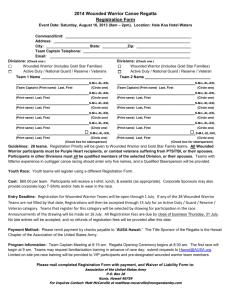USNI_PROCEEDINGS_MAGAZINE_Sept_2009
advertisement
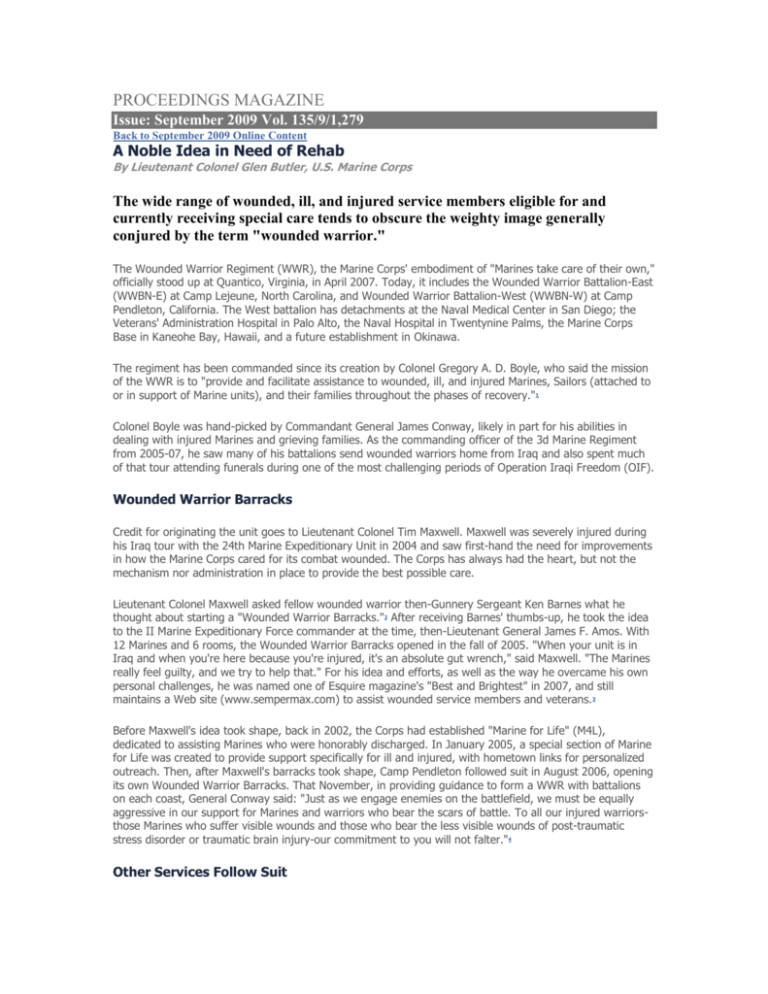
PROCEEDINGS MAGAZINE Issue: September 2009 Vol. 135/9/1,279 Back to September 2009 Online Content A Noble Idea in Need of Rehab By Lieutenant Colonel Glen Butler, U.S. Marine Corps The wide range of wounded, ill, and injured service members eligible for and currently receiving special care tends to obscure the weighty image generally conjured by the term "wounded warrior." The Wounded Warrior Regiment (WWR), the Marine Corps' embodiment of "Marines take care of their own," officially stood up at Quantico, Virginia, in April 2007. Today, it includes the Wounded Warrior Battalion-East (WWBN-E) at Camp Lejeune, North Carolina, and Wounded Warrior Battalion-West (WWBN-W) at Camp Pendleton, California. The West battalion has detachments at the Naval Medical Center in San Diego; the Veterans' Administration Hospital in Palo Alto, the Naval Hospital in Twentynine Palms, the Marine Corps Base in Kaneohe Bay, Hawaii, and a future establishment in Okinawa. The regiment has been commanded since its creation by Colonel Gregory A. D. Boyle, who said the mission of the WWR is to "provide and facilitate assistance to wounded, ill, and injured Marines, Sailors (attached to or in support of Marine units), and their families throughout the phases of recovery."1 Colonel Boyle was hand-picked by Commandant General James Conway, likely in part for his abilities in dealing with injured Marines and grieving families. As the commanding officer of the 3d Marine Regiment from 2005-07, he saw many of his battalions send wounded warriors home from Iraq and also spent much of that tour attending funerals during one of the most challenging periods of Operation Iraqi Freedom (OIF). Wounded Warrior Barracks Credit for originating the unit goes to Lieutenant Colonel Tim Maxwell. Maxwell was severely injured during his Iraq tour with the 24th Marine Expeditionary Unit in 2004 and saw first-hand the need for improvements in how the Marine Corps cared for its combat wounded. The Corps has always had the heart, but not the mechanism nor administration in place to provide the best possible care. Lieutenant Colonel Maxwell asked fellow wounded warrior then-Gunnery Sergeant Ken Barnes what he thought about starting a "Wounded Warrior Barracks."2 After receiving Barnes' thumbs-up, he took the idea to the II Marine Expeditionary Force commander at the time, then-Lieutenant General James F. Amos. With 12 Marines and 6 rooms, the Wounded Warrior Barracks opened in the fall of 2005. "When your unit is in Iraq and when you're here because you're injured, it's an absolute gut wrench," said Maxwell. "The Marines really feel guilty, and we try to help that." For his idea and efforts, as well as the way he overcame his own personal challenges, he was named one of Esquire magazine's "Best and Brightest" in 2007, and still maintains a Web site (www.sempermax.com) to assist wounded service members and veterans. 3 Before Maxwell's idea took shape, back in 2002, the Corps had established "Marine for Life" (M4L), dedicated to assisting Marines who were honorably discharged. In January 2005, a special section of Marine for Life was created to provide support specifically for ill and injured, with hometown links for personalized outreach. Then, after Maxwell's barracks took shape, Camp Pendleton followed suit in August 2006, opening its own Wounded Warrior Barracks. That November, in providing guidance to form a WWR with battalions on each coast, General Conway said: "Just as we engage enemies on the battlefield, we must be equally aggressive in our support for Marines and warriors who bear the scars of battle. To all our injured warriorsthose Marines who suffer visible wounds and those who bear the less visible wounds of post-traumatic stress disorder or traumatic brain injury-our commitment to you will not falter."4 Other Services Follow Suit As is often the case, other services have followed the Marine Corps' lead to some degree. The Army created a Disabled Soldier Support System (DS3) in 2004, changing the name to Army Wounded Warrior program (AW2) in November 2005. The Marine WWR made such an impression on the public and on Congress that in early 2007 the House of Representatives directed the Secretary of the Army to "establish a pilot program at a base with a major medical facility to track and assist outpatients still needing medical treatment who will be assigned to the base. Pilot to be based on Marine Corps Wounded Warrior Regiment."5 The Army's Wounded Warrior program has an "Army Family Covenant" to include family support, a video, "For as Long as It Takes," to explain the process, and a 24-hour call center, the Wounded Soldier and Family Hotline (800-984-8523) (https://www.aw2.army.mil/). The Marine Corps also has a 24-hour call center, started in December 2007 and recently named in honor of Sergeant Merlin German (877-487-6299). Sergeant German was severely wounded and burned over 97 percent of his body by an improvised explosive device in February 2005. After spending more than three years in recovery, he died of surgical complications on 11 April 2008 at age 22. He had been dubbed the "Miracle Man," because few people ever survive burns of that magnitude.6 The U.S. Navy has "Safe Harbor," described as "the focal point for the non-medical care management of severely wounded, ill, or injured Sailors and their families. Providing a lifetime of care, we support and assist Sailors through recovery, rehabilitation, and reintegration."7 The Air Force's program initially was called "Palace HART (Helping Airmen Recover Together)," and targeted "Airmen who have an illness or injury associated with OIF or Operation Enduring Freedom and are medically separated or retired."8 More recently, the service has adopted familiar terminology with its Air Force Wounded Warrior (AFW2) program. Eligibility is determined by its definition of a wounded warrior: "Any Airman that has a combat or hostile-related injury or illness requiring long-term care that will require a Medical Evaluation Board or Physical Evaluation Board to determine fitness for duty. A combat or hostilerelated injury results from hazardous service or performance of duty under conditions simulating war or through an instrumentality of war."9 So, what is the problem? Why question such an appropriate and noble cause-and what some have referred to as a sacred cow around the capital region? Let's start with the terminology, which is both confusing and misleading. Despite what many believe, the WWR supports not only those wounded in combat, but also (as mentioned previously) the injured and the ill. Marines who are injured during training exercises or through other means are eligible for assignment to the WWR. For better or worse, the cliched "wounded warrior" phrase now liberally describes service members who've suffered a wide variety of injuries and illnesses. Even so, much of the public does not realize this, and "wounded warrior" still conjures images of someone wounded in combat. This does not mean to imply that someone wounded in combat is a better person or necessarily more deserving of assistance than a Marine with cancer or injured during a training exercise. Of course, we shouldn't restrict care and resources only to those wounded in combat. But a change in terminology would better describe the mission of the regiment and simultaneously provide a more accurate description of the unit's composition. Possibilities include "Rehabilitation and Reintegration Regiment (R3)," "Semper Fidelis Regiment," or something similar. We should canvas WWR Marines and see what good ideas they might have. Moving on from the terminology, our collective eagerness to provide the best care available highlights another possible flaw with the WWR: compassion combined with guilt can lead to pampering. 'Send Me Back to the Fight' Marines, by nature, are a hard-charging, motivated, go-getting bunch. They thrive on adversity and physical and mental challenges-that's part of their character. Everyone has heard stories about the wounded Marine, who, ignoring his wounds, tells visiting officials: "I just want to get back to my unit, to my Marines. Send me back to the fight." This mentality remains a shared trait of most of our services' warfighters today, as care providers and leaders have a much matured and improved understanding of how to provide treatment necessary for those who need care. General George Patton's infamous slapping and berating of a shell-shocked soldier as a "coward" has been replaced today by a collective appreciation that caring for our wounded Marines and families is our highest priority, second only to combat success. As noted in the Armed Forces Press Service, "other than winning the war, this is the commandant's highest priority."10 Secretary of Defense Robert M. Gates also said, "There is no higher priority for the Department of Defense, after the war itself, than caring for our wounded warriors."11 This is how it should be. But though a definite line exists between compassionate care and pampering, on occasion, wounded warrior programs have the potential to cross that fine line if not properly administered. Major Steve Mount, a UH-1N pilot who lost an eye after being shot during a close-air-support mission in August 2004, told me: "There is a perception that wounded guys have to be treated like children. [Some people] in positions of leadership [are afraid to] to tell these Marines that sometimes they need to get busy living again and quit wallowing in the past." This is admittedly somewhat of a generalization. Mount, who praises the care he's received since 2004 and sees the value in the WWR, also admits some areas could be improved. He has set the example to "get busy living again," exudes an impermeable Sergeant German-like optimism, and remains on active duty-thanks in part to the Marine Corps' leading efforts to provide opportunities to wounded personnel who wish to remain in the service. Obviously, this same can-do spirit applies to the majority of our WWR members. Nevertheless, we must guard against any sort of guilt-induced, patronizing sympathy that can evolve out of issues like the infamous Walter Reed Army Medical Center scandal and that tends to grow with an increase in the number of body bags returning home. Reverting to the Patton mindset is obviously not needed or wanted, but we should not be afraid to practice tough love when warranted, if some choose to abuse the system designed for our warriors. What About the Other Warriors? This leads to another concern. Nearly every congressional or staff delegation, flag officer, distinguished visitor, or celebrity who visits a Marine Corps base or station wants to visit-of course-the wounded warriors. As mentioned previously, civilian visitors normally don't realize that wounded warriors are not only Marines recuperating from combat wounds and sometimes find themselves in mildly awkward situations when they ask everyone they meet questions like "were you wounded in Iraq or Afghanistan?" The intentions behind these visits are sincere, the visits usually do boost the morale of our WWR Marines, and showing the public our wounded warriors and the program they're participating in is a piece of the Marine Corps' strategic communications plan. But sometimes these visits have a negative effect, as WWR Marines must primp, muster, and wait around on a very regular basis. The charity, non-profit, and political worlds thrive on such events, and these visits indeed carry many benefits. The inconvenience to our WWR personnel is surmountable, but there is another downside to these frequent occurrences: they exclude the thousands of other outstanding warfighters who don't receive similar attention. Rarely does anyone ask to see them. Thus, as much as feasible and within reason, we should attempt to limit these visits to a degree. Otherwise, we risk repeatedly using the WWR Marines as photo props, perhaps in part to make ourselves feel better and ease the survivors' guilt that we are not in their shoes. Finally, hundreds, if not more, wounded Marines remain in the operating forces outside the WWR, and a higher number of non-wounded combat vets and future combat vets are serving with distinction across the Corps. WWR barracks are arguably the finest in the Corps, with an initial $53 million spent for new construction for the two battalions' barracks. But we should be careful to not alienate those "normal Marines" equally deserving of such amenities, as many of them wait for their regular barracks and furnishings to be refurbished or replaced. Let Warfighters Support Warrior Care Between 2001 and March 2009, almost 8,900 Marines have been wounded. Of these, approximately 300 were in Afghanistan. Those numbers will undoubtedly increase as our presence accelerates in that region. So the need for a program such as WWR will continue for the immediate future. But there might come a time when the WWR could be decommissioned, if combat casualties have dissipated. Active-duty units understandably support the WWR's existence in permanent status, as transferring Marines to the WWR allows them to receive full-status replacements. One long-range course of action that should be considered, however, is the transfer of resources and support personnel from WWR to warfighting units, so they could better support warrior care on their own. Marines want to be around "their Marines," and many would prefer to remain out of WWR if we could make that opportunity feasible. Private First Class Jeffrey Huben, wounded by an IED near Fallujah before WWR existed, remarked about his hospitalization: It's tough being there because you're constantly surrounded by not only the horrors of war, but every day we get a motorcycle accident or a cancer patient in there. . . . When I got to come over here [Headquarters and Service Battalion at Marine Corps Recruit Depot San Diego], I got to come back to the mentality of "we have a purpose, we have a mission, and even if you're limited in some kind of way, that mission needs to be executed, that mission has got to get done, and we'll adapt and overcome and work to that mission." 12 Some of the recent positive changes for wounded warrior support include a new disability process, an EyeTrauma Center under development, and a new DOD Web site to serve as a portal to all (wounded) warrior information (http://www.WarriorCare.mil).13 The National Resource Directory (www.nationalresourcedirectory.org) provides "wounded, ill, and injured service members and veterans, their families, families of the fallen and those who support them with a Web-based directory of valuable resources." Recovery Care Coordinators "oversee and assist the service members and their families throughout the care, management, transition, and rehabilitation services provided by the Federal Government (including those provided by the Departments of Defense, Veterans Affairs, Labor, and the Social Security Administration)." And other support mechanisms come in the form of charity-sponsored trips, hunting outings, concerts, and a plethora of Web sites, staff, funding, and administrative help across all services and federal and non-governmental support agencies. The bottom line, perhaps controversial, is that the WWR is still in need of some rehab and should evolve as necessary to meet the transitional needs of our Marines and Sailors. As the WWR commanding officer said, "the Marine Corps is an adaptive organization that is constantly evolving to meet current mission requirements and the needs of its people."14 In this vein, it is time for the WWR to adapt. There can be no doubt that we owe it to all Marines and Sailors to make sure we continue to provide the best-and most appropriate-treatment and support possible, and truly live up to the WWR's current motto: "Etiam in Pugna (Still in the Fight)." 1. See www.woundedwarriorregiment.org and Carmen L. Gleason, "New Regiment Focuses on Wounded Marines, Sailors," American Forces Press Service, 5 April 2007. 2. See Jennifer Hlad, "Changing the Way a Corps Thinks," www.woundedwarriorregiment.org, 19 July 2008. 3. LCPL Kate Mathison, "East Coast Wounded Warrior Battalion Activated," http://www.iimefpublic.usmc.mil, 29 June 2007. 4. Karcher, Mary D., "Taking Care of Our Own: Wounded Warrior Regiment Stands Up," quoting the CMC's 2006 planning guidance. 5. Via H.R. 1538, the Wounded Warrior Assistance Act of 2007 (Sarah A. Lister, Sidath Viranga Panangala, and Richard A. Best, Jr., "Comparison of 'Wounded Warrior' Legislation: H.R. 1538 as Passed in the House and Senate," Congressional Research Service Report for Congress, 27 July 2007). 6. On SGT Merlin German: "His positive attitude and outright refusal to let his injuries affect his soul and how he lived were an inspiration to everyone who came in contact with him." COL Boyle, WWR Commanding Officer 7. http://npc.navy.mil/ 8. Derek Kaufman, "Palace HART making a difference in the lives of Airmen," http://www.afmc.af.mil/news/, 11 September 2007. 9. http://www.woundedwarrior.af.mil/ 10. Fred W. Baker II, "Staying Power, Marines Call Wounded Care Highest Priority After War," American Forces Press Service, 20 November 2008. 11. http://www.warriorcare.mil/ 12. Karcher, "Taking Care of Our Own . . . ." 13. See Kelly Kennedy, "Severely Injured Get New Disability Process," ArmyTimes.com, 22 January 2009 and Gregg Zoroya, "Funding Spat Stalls Eye-Trauma Center for Troops," USA Today, 29 January 2009, p. 5. November 2008 was designated "Warrior Care Month." 14. Karcher, "Taking Care of Our Own . . . ." Lieutenant Colonel Butler is operations officer at Marine Corps Base Hawaii. His most recent Proceedings article appeared in April 2007.
